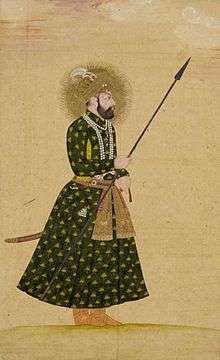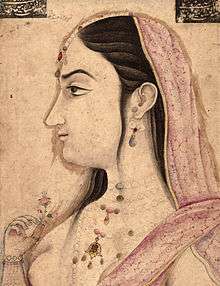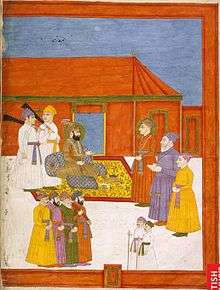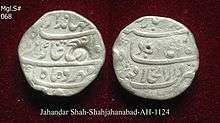Jahandar Shah
Mirza Muhammad Mu'izz-ud-Din (Persian: میرزا معزلدین محمد ;9 May 1661 – 12 February 1713),[1][2] more commonly known as Jahandar Shah (Persian: جهاندار شاه), was a Mughal Emperor who ruled for a brief period in 1712–1713. His full title was Shahanshah-i-Ghazi Abu'l Fath Mu'izz-ud-Din Muhammad Jahandar Shah Sahib-i-Qiran Padshah-i-Jahan (Khuld Aramgah). Sailendra Sen describes him as "a worthless debauch [who] became emperor after liquidating his three brothers".[3]
| Jahandar Shah | |||||
|---|---|---|---|---|---|
| Padishah of the Mughal Empire Jahandar Shah | |||||
 | |||||
| 8th Mughal Emperor | |||||
| Reign | 27 February 1712 – 11 February 1713 | ||||
| Coronation | 29 March 1712 at Lahore | ||||
| Predecessor | Bahadur Shah I | ||||
| Successor | Farrukhsiyar | ||||
| Born | 9 May 1661 Deccan, Mughal Empire | ||||
| Died | 12 February 1713 (aged 51) Delhi, Mughal Empire | ||||
| Burial | |||||
| Spouse | Sayyid-un-Nissa Begum Lal Kunwar Anup Bai One another wife | ||||
| Issue | Izz-ud-Din Mirza Azz-ud-din Mirza Alamgir II Iffat Ara Begum Rabi Begum | ||||
| |||||
| Dynasty | Timurid | ||||
| Father | Bahadur Shah I | ||||
| Mother | Nizam Bai | ||||
| Religion | Islam | ||||
Early life
Prince Jahandar Shah was born in Deccan Subah to the later Emperor Bahadur Shah I. His mother was Nizam Bai, the daughter of Fatehyawar Jang, a noble from Hyderabad.[4]
Jahandar Shah was appointed as Vizier of Balkh in 1671 by his grandfather, Aurangzeb. When their father died on 27 February 1712, he and his brother, Azim-ush-Shan, both declared themselves emperor and battled for succession. Azim-us-Shan was killed on 17 March 1712, after which Jahandar Shah ruled for an additional eleven months. Before ascending the throne, Jahandar Shah sailed around the Indian Ocean and was a very prosperous trader. He was also appointed Subedar of Sindh. He fathered three sons, including Aziz-ud-Din, who reigned as Mughal emperor between 1754 and 1759.
Reign


Jahandar Shah led a frivolous life, and his court was often enlivened by dancing and entertainment. He chose a favourite wife, Lal Kunwar, who was a mere dancing girl before her elevation to the position of Queen Consort. Together they shocked the Mughal Empire and were even opposed by Aurangzeb's surviving daughter, Zeenat-un-Nissa.[5]
His authority was rejected by the third Nawab of the Carnatic, Muhammed Saadatullah Khan I, who killed De Singh of Orchha, primarily due to the Nawab's belief that he was the righteous commander of the Gingee Fort. Khan began a smear campaign referring to Jahandar Shah as an usurper to the Mughal throne. To further strengthen his authority, Jahandar Shah sent gifts to the Ottoman Sultan Ahmad III.[6]
Marriages
Jahandar Shah's first wife was the daughter of Mirza Mukarram Khan Safavi. The marriage took place on 13 October 1676.[7] After her death he married her niece, Sayyid-un-nissa Begum, the daughter of Mirza Rustam. The marriage took place on 30 August 1684.[8] Qazi Abu Sa'id united them in the presence of Emperor Aurangzeb, and Prince Muhammad Muazzam (future Bahadur Shah I).[9] The marriage was consummated on 18 September. Sayyid-un-nissa Begum was presented with jewels worth 67,000 rupees. The celebrations were supervised by Princess Zinat-un-nissa Begum.[5]
His third wife was Anup Bai. She was the mother of Prince Muhammad Aziz-ud-din Mirza, born on 6 June 1699. She died at Delhi on 17 April 1735,[8] nineteen years before her son's accession to the throne as Emperor Alamgir II. His fourth wife was Lal Kunwar, the daughter of Khasusiyat Khan.[10] Jahandar Shah was very fond of her, and after his accession to the throne, he gave her the title Imtiyaz Mahal.[8]
Death

He was defeated in the battle at Agra on 10 January 1713 by Farrukhsiyar, his nephew and the second son of Azim-ush-Shan, with the support of the Sayyid Brothers. He fled to Delhi where he was captured and handed over to the new Emperor, who confined him along with Lal Kunwar. He lived in confinement for a month, until 11 February 1713, when professional stranglers were sent to murder him.
Coins
Jahandar Shah reintroduced couplets and issued coins in gold, silver, and copper. Two couplets i.e. Abu al-Fateh and Sahab Qiran were used. Copper coins were issued in both weight standard i.e. 20 grams and 14 grams.
 Silver Rupee of Abu al-Fateh couplet, Khujista Bunyaad, AH1124 Ry.Ahd
Silver Rupee of Abu al-Fateh couplet, Khujista Bunyaad, AH1124 Ry.Ahd Silver Rupee of Sahab Qiran couplet, Itawa, AH1124 Ry.Ahd
Silver Rupee of Sahab Qiran couplet, Itawa, AH1124 Ry.Ahd Copper paisa of 20.21 grams from Surat mint
Copper paisa of 20.21 grams from Surat mint Copper paisa of 13.85 grams from Surat mint
Copper paisa of 13.85 grams from Surat mint
Notes
- Nigam, S. B. P. (1983). The Jahandarnamah of Nur- ud-rin. Journal of Indian History. 61. Department of Modern Indian History. p. 95.
- Montgomery-Massingberd, Hugh (1977), Burke's Royal Families of the World, II, Burke's Peerage, p. 139, ISBN 978-0-85011-029-6
- Sen, Sailendra (2013). A Textbook of Medieval Indian History. Primus Books. p. 193. ISBN 978-9-38060-734-4.
- Muni Lal, Mini Mughals (1989) p. 28
- Sarkar 1947, p. 152.
- Farooqi, Naimur Rahman (1 January 1989). Mughal-Ottoman relations: a study of political & diplomatic relations between Mughal India and the Ottoman Empire, 1556-1748. Idarah-i Adabiyat-i Delli.
- Sarkar 1947, p. 93.
- Irvine, p. 242.
- Sarkar 1947, p. 151.
- Irvine, p. 180.
References
- Sarkar, Jadunath (1947). Maasir-i-Alamgiri: A History of Emperor Aurangzib-Alamgir (reign 1658-1707 AD) of Saqi Mustad Khan. Royal Asiatic Society of Bengal, Calcutta.
- Irvine, William. The Later Mughals. Low Price Publications. ISBN 8175364068.
| Wikimedia Commons has media related to Jahandar Shah. |
External links
Jahandar Shah | ||
| Preceded by Bahadur Shah I |
Mughal Emperor 1712–1713 |
Succeeded by Farrukhsiyar |